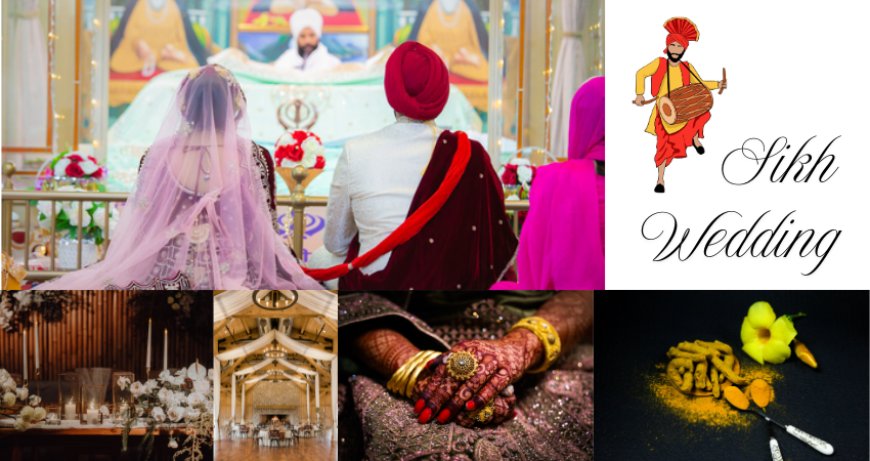From Mehndi to Reception: Timeline for a Sikh Wedding
This blog provides a comprehensive timeline for a Sikh wedding, covering every stage from the Mehndi to the Reception. It guides couples and families through essential pre-wedding planning, key rituals like the Sangeet, Maiyaan, Anand Karaj, and Doli, and wraps up with the grand wedding reception. It also highlights the importance of hiring a knowledgeable Sikh wedding planner, using creative Sikh wedding decorations, and incorporating thoughtful wedding reception decorations and event decor supplies. With added touches like a pre-wedding shoot and well-coordinated decor, the guide ensures your Sikh wedding is beautiful, meaningful, and unforgettable.
A Sikh wedding is not just a union of two individualsit is a beautiful tapestry woven from sacred rituals, vibrant traditions, emotional family moments, and spirited celebrations. Whether you're a couple planning your big day or a Sikh wedding planner helping a family navigate the process, understanding the timeline of events from the Mehndi to the Reception is essential. With the right preparation and the support of expert wedding decorators near me Brampton, you can bring to life a wedding celebration thats both traditional and unforgettable.
In this blog, well walk through a detailed timeline for a Sikh weddingfrom pre-wedding rituals like the Mehndi and Sangeet to the emotional Anand Karaj and the lively Reception. Well also explore the role of Sikh wedding decorations, how to time each function, and where event decor supplies and a pre-wedding shoot fit into your celebration journey.
Pre-Wedding Planning (612 Months Before)
Booking the Venue and Key Vendors
The foundation of any successful Sikh wedding begins with early planning. Ideally, couples should begin the process 6 to 12 months before the wedding date. During this time, focus on:
-
Choosing a Sikh wedding planner who understands religious customs and can coordinate all logistics.
-
Booking your Gurudwara for the Anand Karaj ceremony.
-
Securing venues for the Mehndi, Sangeet, and Reception.
-
Hiring wedding decorators, caterers, photographers, DJs, and florists.
-
Planning a Pre-Wedding Shoot in Canada, which typically happens 23 months before the wedding.
This stage also includes finalizing your guest list, sending out save-the-dates, and selecting themes and Sikh wedding decorations that reflect your personal style.
Pre-Wedding Events (37 Days Before the Wedding)
The week leading up to the wedding is packed with cultural significance, prayer ceremonies, music, and joyous gatherings. Lets break down this timeline day-by-day.
Day 1: Mehndi Ceremony
Location: Brides home or intimate party venue
Who Attends: Primarily women from both families
The Mehndi ceremony is one of the most cherished pre-wedding events in Sikh culture. Its a celebration of beauty, tradition, and womanhood, where henna is applied to the brides hands and feet in intricate designs.
Key Elements:
-
Bright, colorful event decor supplieslike marigold backdrops, fairy lights, cushions, and low seating.
-
Live dhol player or pre-recorded Punjabi music.
-
Traditional snacks and mocktails.
-
Brides entrance captured beautifully for social media and family albums.
This is also a great moment to incorporate personalized Sikh wedding decorations, like a custom Mehndi stage, photo booth, and family message board.
Day 2: Sangeet or Jaggo Night
Location: Banquet hall or outdoor tent
Who Attends: Entire extended family, friends, and sometimes both sides together
The Sangeet is all about music, dance, and uniting families. In some Sikh families, the Jaggo tradition (carrying decorated pots with candles and singing folk songs through the streets) is still observed, usually late at night.
Tips:
-
Coordinate performances by family members and friends.
-
Create a Sangeet stage with vibrant wedding reception decorations like LED lights, disco balls, and drapes.
-
Serve a buffet with traditional Punjabi dishes like chole bhature, tandoori snacks, and mithai.
Hiring a professional DJ and ensuring mood lighting can turn this into the most high-energy night of your wedding week.
Day 3: Maiyaan and Chura Ceremony
Location: Bride and grooms respective homes
Who Attends: Immediate family
This is a quieter, more sacred day. The Maiyaan involves the application of turmeric paste on the bride and groom to enhance their glow. The Chura ceremony, performed at the brides home, involves the maternal uncle gifting the bride her bridal bangles.
Decor and Planning:
-
Minimalist yet elegant floral wedding decorators can enhance the spiritual tone.
-
Use soft pastels and gold for drapes, flowers, and seating arrangements.
-
Play light instrumental kirtan in the background to maintain a spiritual atmosphere.
You can also schedule the pre-wedding shoot during this window, capturing intimate and emotional family moments before the big day.
The Wedding Day (Anand Karaj Ceremony)
Location: Gurudwara
Time: Morning (typically starts early, between 8 a.m. to 10 a.m.)
The spiritual heart of a Sikh wedding is the Anand Karaj, meaning "Blissful Union." Held in a Gurudwara or a dedicated prayer space, this ceremony is pure, serene, and deeply meaningful.
Morning Timeline:
-
5:30 AM: Bride and groom start getting ready.
-
7:00 AM: Baraat (groom's procession) arrives with traditional dhol beats and dancing.
-
7:30 AM: Milni ceremonyformal introduction and garland exchange between the two families.
-
8:00 AM: Guests enter the Gurudwara and partake in breakfast/langar.
-
8:30 AM to 10:00 AM: Anand Karaj ceremony takes place with four Lavan (hymns) sung as the couple circles the Guru Granth Sahib.
Decor Style:
Even though Sikh weddings are spiritual and not flashy during the Anand Karaj, tasteful Sikh wedding decorations are still welcome:
-
Fresh floral arrangements at the Gurudwara entrance.
-
White and gold drapes for the prayer hall (with Gurudwara permission).
-
Subtle centerpiece arrangements for the langar area.
Make sure you also arrange for comfortable floor seating, shoe racks, and hydration stations for guests.
Doli Ceremony (Post-Wedding)
Immediately after the Anand Karaj and langar, the bride bids an emotional farewell to her family in the Doli ceremony. This is one of the most heart-touching parts of a Sikh wedding.
Timing: 11:00 AM 12:00 PM
This is also when a well-planned wedding planner ensures smooth transportation and coordination between the two families. Keep a few tissues nearbythis part always draws tears.
Wedding Reception
Location: Banquet hall or outdoor venue
Time: Evening (usually 6 PM onward)
After a spiritual morning, the newlyweds and their families can finally let loose and party at the wedding reception. This is where glamour, grandeur, and personalization truly shine.
Reception Timeline:
-
6:00 PM: Guest arrivals and cocktail hour
-
7:00 PM: Couple grand entrance with music, sparklers, and cold fireworks
-
7:30 PM: Dinner is served
-
8:30 PM: Speeches and cake cutting
-
9:00 PM onward: Dance floor opens
Reception Decor Must-Haves:
-
LED-lit floral centerpieces and chandeliers
-
Luxurious stage backdrop with sequin draping or digital screens
-
Personalized signage, monograms, or neon signs
-
Photobooth with props related to Punjabi culture
-
Entryway arches created with event decor supplies like fabric, florals, and candles
Pro tip: Align your wedding reception decorations with your pre-wedding theme for continuity.
Final Touch: After-Party or Post-Reception Gathering
Some families host a low-key gathering the next day for brunch or a relaxing celebration at home. This can be a great time to distribute thank-you favors, relive memories, and catch up with guests before everyone heads home.
Final Thoughts
A Sikh wedding is a magnificent blend of faith, family, and festivity. From the soulful Anand Karaj to the electric energy of the Reception, every stage is a memory in the making. With the right wedding decorators, thoughtful event decor supplies, and an organized Sikh wedding planner, you can create a celebration that honors tradition while celebrating modern love.
So whether youre hosting a grand multi-day affair or keeping it close-knit, use this timeline as your guideand let the celebration of love unfold with grace, joy, and color.







































